The Dogras or Dogra people, are an Indo-Aryan ethno-linguistic group living primarily in the Indian union territory of Jammu and Kashmir and neighbouring Pakistan, consisting of the Dogri language speakers. They live predominantly in the Jammu region of Jammu and Kashmir, and in adjoining areas of Punjab and Himachal Pradesh. Some also live in northeastern Pakistan. Their historical homeland is known as Duggar.

Doda district is an administrative district of the Jammu division of Indian-administered Jammu and Kashmir in the disputed Kashmir region.
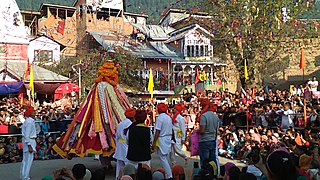
Bhaderwah or Bhadarwah is a town, tehsil, and sub-district in the Doda district of Jammu Division of Jammu and Kashmir, India.
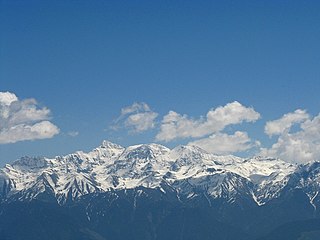
The Pir Panjal Range is a range of mountains in the Lower Himalayan region located in the Western Himalayas of northern Indian subcontinent. It runs southeast to northwest between the Beas and Neelam/Kishanganga rivers, in the Indian state of Himachal Pradesh and Indian-administered union territory of Jammu and Kashmir, with its northwestern end extending into territory administered by Pakistan. The Himalayas show a gradual elevation towards the Dhauladhar and Pir Panjal ranges. Pir Panjal is the largest and westernmost range of the Lesser Himalayas. Near the bank of the Sutlej River, it dissociates itself from the main Himalayan range and forms a divide between the Beas and Ravi rivers on one side and the Chenab on the other. Further west, the Pir Panjal range forms the southwestern boundary of the Kashmir Valley, separating it from the hills of Jammu region, forming a divide between the Jhelum and Chenab rivers.

Zorawar Singh was a military general of the Dogra Rajput ruler, Gulab Singh of Jammu. He served as the governor (wazir-e-wazarat) of Kishtwar and extended the territories of the kingdom by conquering Ladakh and Baltistan. He also boldly attempted the conquest of Western Tibet but was killed in battle of To-yo during the Dogra-Tibetan war. In reference to his legacy of conquests in the Himalaya Mountains including Ladakh, Tibet, Baltistan and Skardu as General and Wazir, Zorowar Singh has been referred to as the "Napoleon of India", and "Conqueror of Ladakh".

Chamba is a town in the Chamba district in the Indian state of Himachal Pradesh. According to the 2001 Indian census, Chamba has a population of 20,312 people. Located at an altitude of 1,006 metres (3,301 ft) above mean sea level, the town is situated on the banks of the Ravi River, at its confluence with the Sal River.

Jammu and Kashmir is home to several valleys such as the Kashmir Valley, Chenab Valley, Sindh Valley and Lidder Valley. Some major tourist attractions in Jammu and Kashmir are Srinagar, with its renowned Dal Lake and Mughal Gardens, Gulmarg, Pahalgam, Bhaderwah, Patnitop and Jammu. Every year, thousands of Hindu pilgrims visit holy shrines of Vaishno Devi and Amarnath which has had a significant impact on the state's economy.

Kishtwar district is an administrative district of the Jammu division of Indian-administered Jammu and Kashmir in the Jammu Division. As of 2011, it is the largest and the least populous district of Jammu and Kashmir.

Sach Pass is a 4,414-metre-high (14,482 ft) mountain pass in Chamba District, Himachal Pradesh, India on the Pir Panjal range of the Himalayas. It is 127 km (79 mi) from the District Headquarters. It connects the Chamba valley with the Pangi valleys of Himachal Pradesh, India. There is a helipad on the ascent towards Sach pass from Bairagarh of Himachal Pradesh.
Salooni is the tehsil headquarter and Sub-Division in Chamba district of Himachal Pradesh, India. Salooni is an important regional administrative and economic centre. It has a mini secretariat, SDM office, government senior secondary school, Degree College,CSK HP Krishi Vishvavidyalaya Mountian Agriculture Research and Extension Stations, community health centre and many other sub-division level important government offices. Salooni falls under Dalhousie legislative constituency. The entrance to the small township has a series of few quaint shops, followed by small ground with an ancient goddess Kali temple at other end.

Machail Chandi Mata Temple, popularly known as Machail Mata, is a shrine of the Hindu goddess Durga in the village Machail of Sub Division Paddar, in Kishtwar District of Jammu region in the Indian union territory of Jammu and Kashmir. It is near tributaries of the Chenab River. The area is home to a Buddhist community and the Thakur community who are serpent worshipers, and was merged with Kishtwar tehsil, by Maharaja Ranbir Singh. Thousands of pilgrims, mainly from Jammu region, visit the shrine every August.
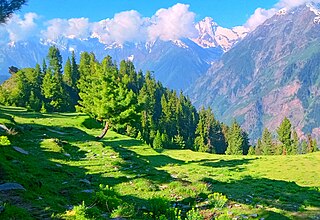
Pangi is a tehsil of Chamba, Himachal Pradesh, India. The Pangi Valley is divided into the sural bhatori, hudan bhatori, kumar bhatori, hilu tuwaan bhatori and chasag bhatori

The Bodh people, also known as Khas Bhodi, are an ethnic group of Himachal Pradesh, India. They are found in Lahaul tehsil, Lahaul and Spiti district, predominantly in the Bhaga and Chandra valleys, but also to a lesser extent in Pattani valley, Miyar Valley, in the upper reaches of Pangi, Himachal Pradesh and Paddar valley, Jammu and Kashmir. Their religion is predominantly Buddhism with animistic and shaivite practices. Caste wise, they are identified as Rajput, Thakur or Kshetri although caste rules are not as rigid as in the plains. Historically, 3-4 prominent families of the area were accorded the titles of Rana, Wazir or Thakur by the kings of Chamba, Kullu or Ladakh for the purpose of general administration and revenue collection. They have a mix of martial traditions alongside shamanistic and lamaistic beliefs. Certain families/clans used to be significant zamindars/jagirdars. There is a significant cultural and ethnic mixing due to the region passing under the hegemony of rulers of Ladakh, Kullu and Chamba over the last many centuries. The language spoken differs from valley to valley with some dialects being very close to Kumaoni, while others are mixed with Chambyali and Dari. They are progressive, enterprising, honest and were involved in the centuries old India-Tibet-Nepal trading routes. Organized into family groups/clans with clan names ending in the suffix "-pa" similar to the "-ta" suffix found in the family/clan names of the Simla area.
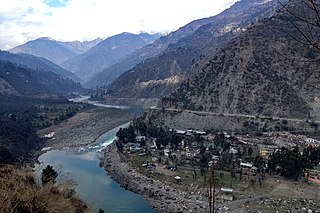
The Chenab Valley is a river valley formed by the Chenab River. The term is also used collectively for Doda, Kishtwar and Ramban districts of Jammu Division in the Indian-administered Jammu and Kashmir. These districts were formerly part of a single district, called Doda.

The Jammu division is a revenue and administrative division of the Indian-administered Jammu and Kashmir in the disputed Kashmir region. It is bordered by the Kashmir division to the north. It consists of the districts of Jammu, Doda, Kathua, Ramban, Reasi, Kishtwar, Poonch, Rajouri, Udhampur and Samba. Most of the land is hilly or mountainous, including the Pir Panjal Range which separates it from the Kashmir Valley and part of the Great Himalayas in the eastern districts of Doda and Kishtwar. Its principal river is the Chenab.
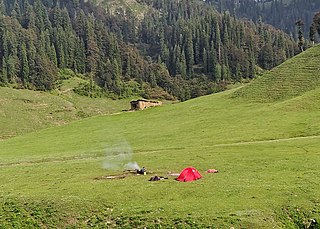
Bhal Padri is a hill station situated above a group of small valleys covered with a dense forest located in the Changa, Bhalessa. area of Doda district. It borders Padri Pass, Bhaderwah at a distance of 4 kilometres (2.5 mi) northeast. Rivulets and streams flow through this valley.

Bhalessa is a geographical area within Doda district in the Jammu region of India-administered Kashmir. It consists of the Bunjwah and Bhalessa Valleys, and comprises the three Tehsils of Kahara, Chilly Pingal and Gandoh.
Gandhari is a valley in Kishtwar district of Jammu and Kashmir region of India. It is an extension of Paddar Valley and abuts the other Indian territories of Ladakh and Himachal Pradesh.

The Bhaderwah–Chamba Road is an interstate link road that connects the Indian states of Jammu and Kashmir and Himachal Pradesh. The road runs through the valleys and mountains of the western Himalayas, providing a transportation link between the two states.


























